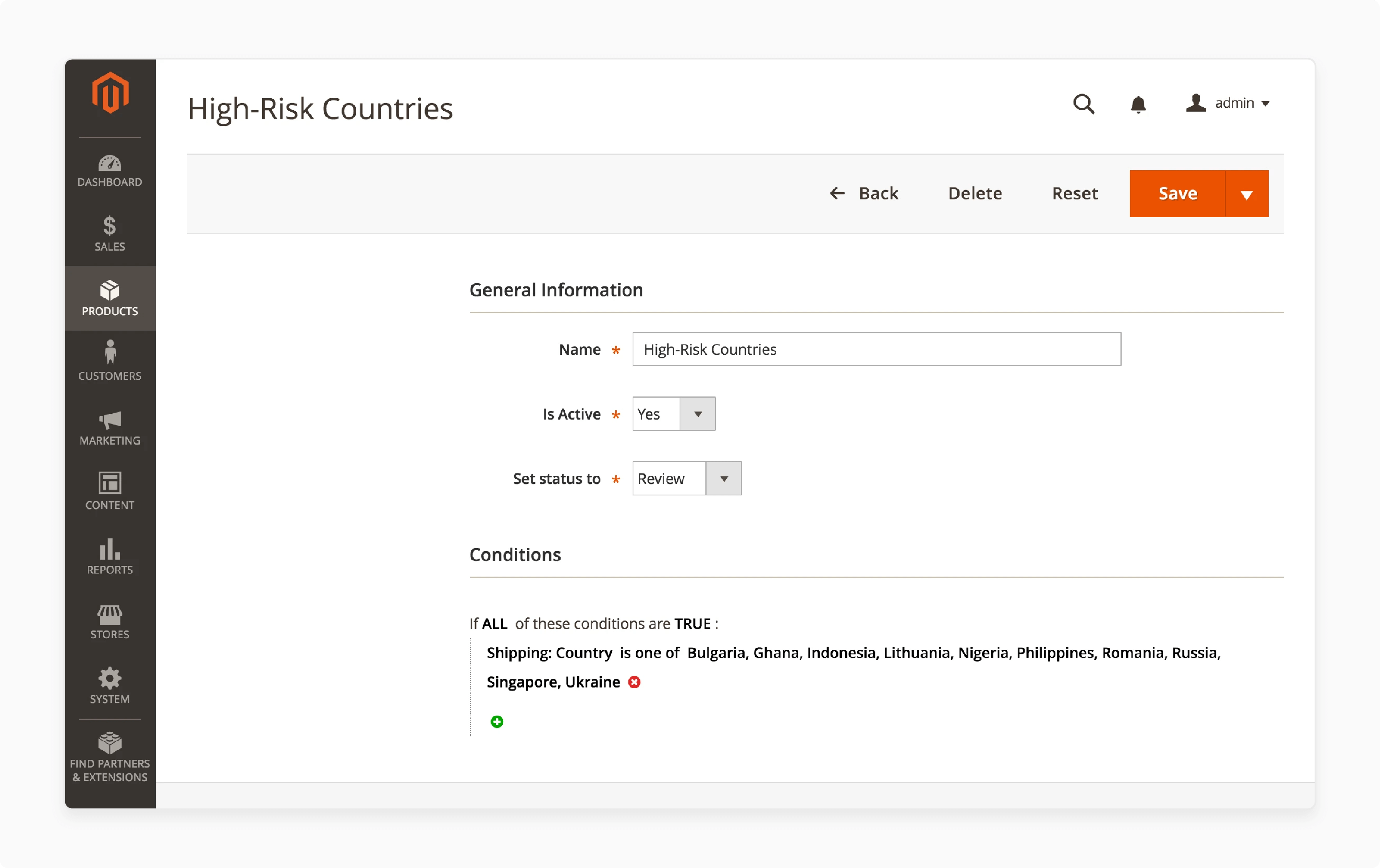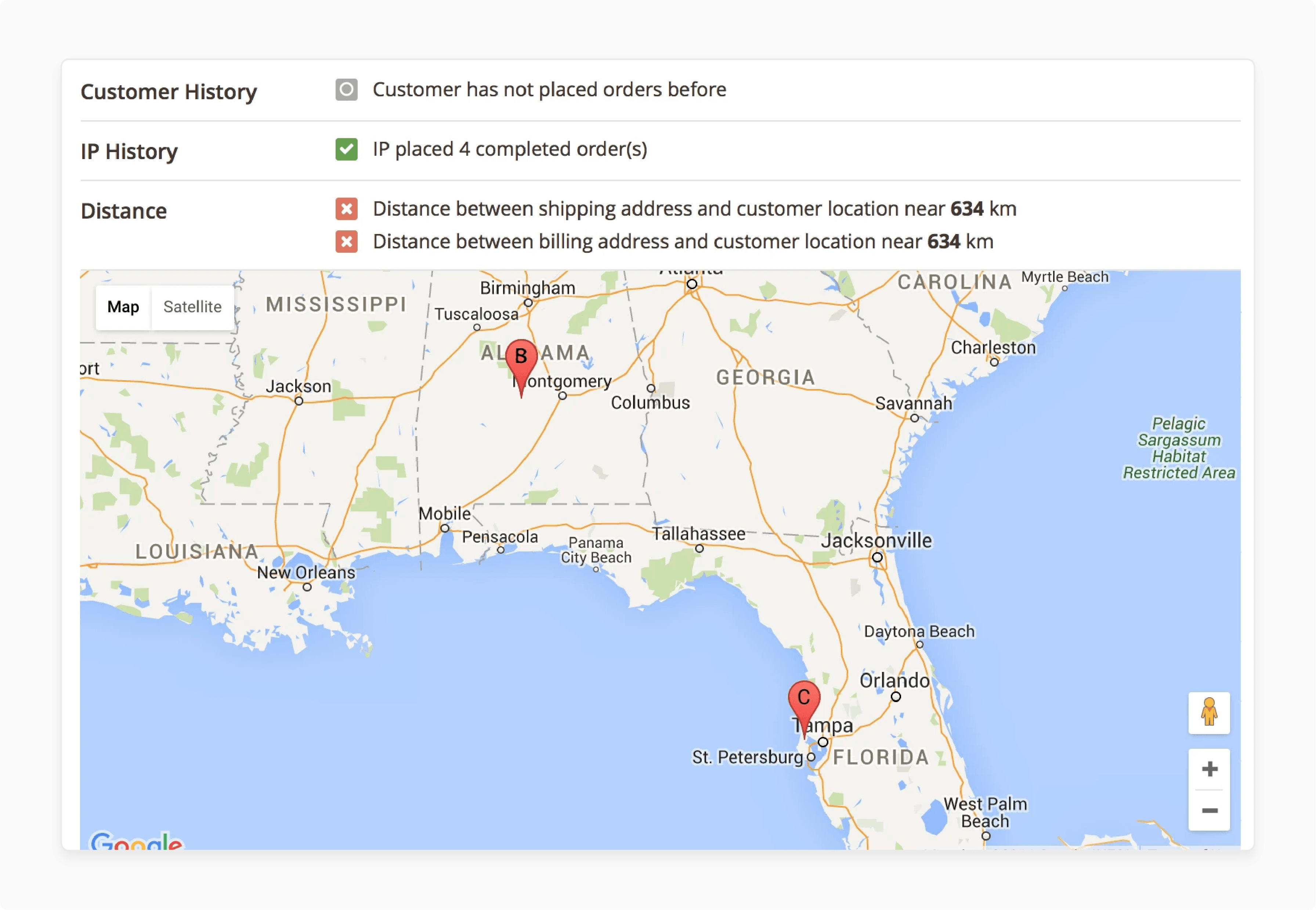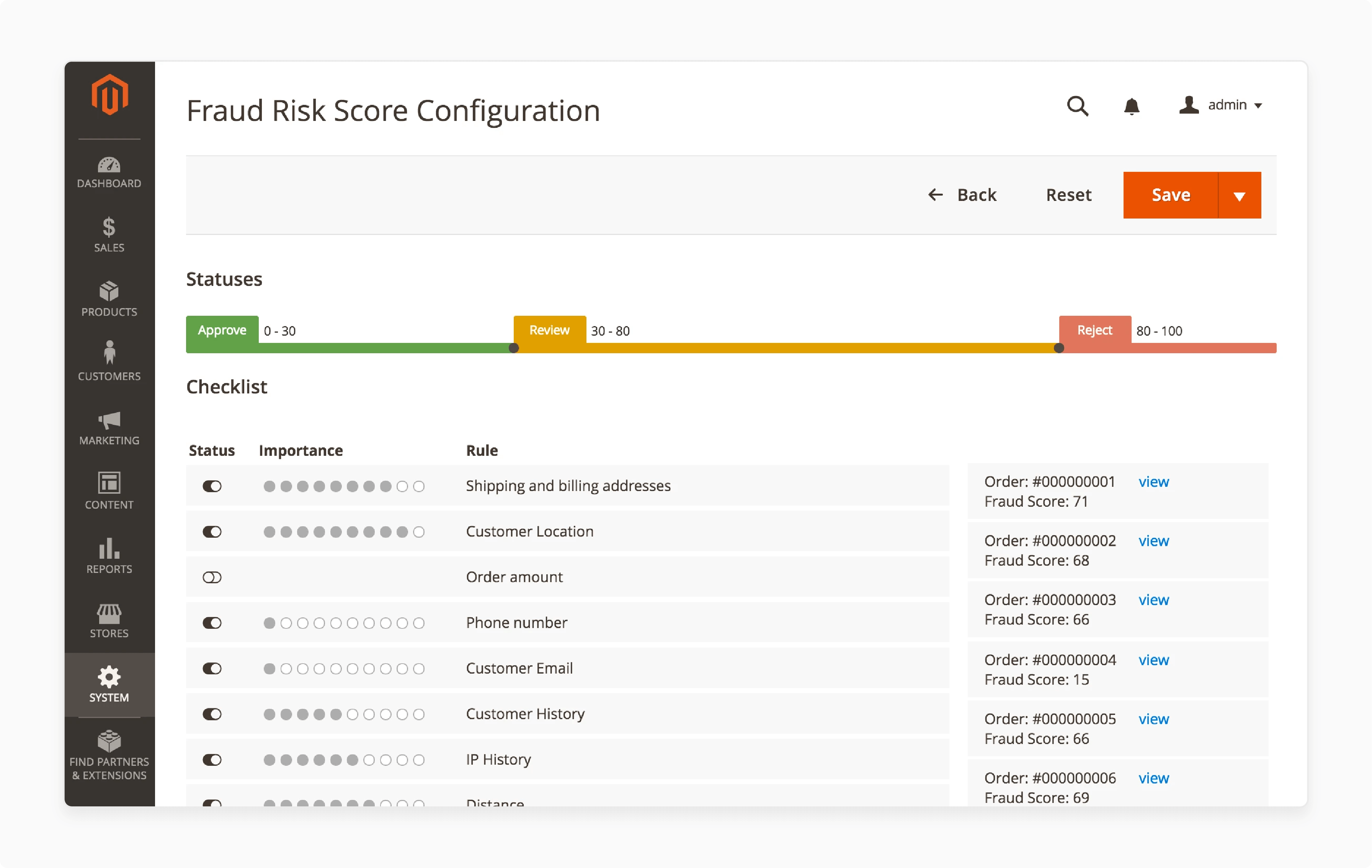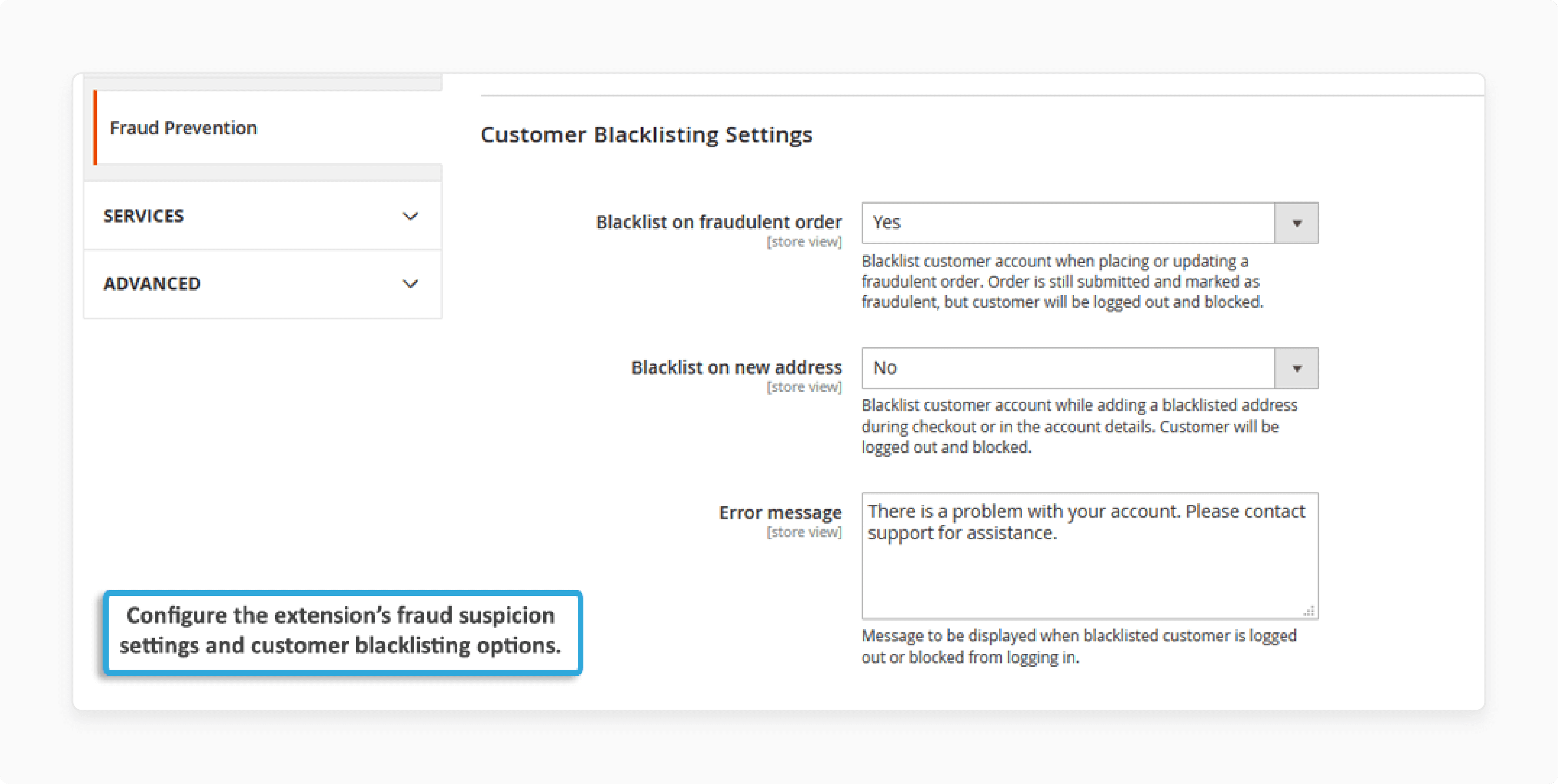
Magento Fraud Protection: Key Features and Tools Used
Want to reduce chargebacks and protect your profits? Magento fraud protection offers a comprehensive solution to safeguard your online store from fraudulent transactions.
In this article, we will explore the key features and tools used for Magento fraud protection.
Key Takeaways
-
Real-time fraud detection tools protect your business.
-
Customizable fraud rules help manage risk.
-
Machine learning improves fraud detection over time.
-
Implement strong authentication for added security.
-
Geo-location checks and AVS can help spot fraud early.
What is Magento Fraud Protection?
Magento fraud protection is a security tool designed to safeguard online stores from fraudulent transactions.
The fraud protection tool helps identify and prevent fraud, such as:
-
Payment fraud
-
Chargebacks
-
Identity theft
The system flags suspicious orders in real-time by analyzing customer behavior and transaction data. It allows store owners to review and act on fraudulent transactions before processing.
Magento fraud prevention extension uses advanced algorithms and machine learning to improve its accuracy over time. It reduces the risk of fraud and ensures safer online shopping experiences for both merchants and customers.
Key Features of Magento Fraud Protection
1. Real-Time Fraud Detection
-
Magento fraud protection continuously scans transactions as they occur.
-
It uses advanced algorithms to detect potentially fraudulent behavior based on factors like:
1. Location
2. IP address
3. Transaction history
-
It allows store owners to catch fraud before orders are processed.
2. Customizable Fraud Rules

-
Merchants can set specific rules and parameters to flag suspicious orders.
-
A store owner might set rules to flag orders from specific countries or high-risk payment methods automatically.
-
Customizing these rules ensures the fraud protection system aligns with the business's unique needs.
3. Order Review System
-
When a potentially fraudulent order is flagged, it enters an order review queue.
-
Merchants can manually assess the order by checking:
1. Customer details
2. Payment information
3. Order history
-
It is done before deciding whether to approve or reject the transaction. The feature allows businesses to make informed decisions on risky transactions.
4. Machine Learning
-
Magento fraud protection continuously uses machine learning technology to improve its fraud detection accuracy.
-
The system becomes better at identifying new fraud tactics over time. It is by analyzing past transactions and fraud patterns.
-
The adaptive approach helps merchants stay ahead of evolving fraud strategies.
5. Chargeback Prevention
-
Magento fraud protection helps reduce the chances of chargebacks. It can be costly for merchants. It is by identifying suspicious transactions early.
-
The system flags high-risk orders that are more likely to result in chargebacks. It allows merchants to prevent them before they happen.
6. Risk Scoring
-
Each transaction is assigned a risk score based on various factors like:
2. Payment details
3. Transaction amount
-
A higher score indicates a greater likelihood of fraud. Merchants can then review transactions with higher scores more carefully. It improves their ability to detect fraud.
7. Secure Payment Gateways
-
Magento fraud protection integrates with trusted and secure payment gateways. It provides an added layer of protection.
-
These gateways use encryption and other security measures. It ensures that payment details are kept safe from hackers. It further reduces the risk of fraudulent activities.
Real-time Fraud Detection Tools in Magento
1. Magento Fraud Protection
-
The built-in tool analyzes transactions in real-time. It flags suspicious activities based on predefined rules or risk factors.
-
It uses algorithms to detect patterns of fraud, such as:
1. Unusual payment methods
2. High-value orders
3. Inconsistent shipping information
2. Third-Party Fraud Detection Extensions
-
Magento integrates with various third-party fraud detection services like:
1. Signifyd
2. Kount
3. MaxMind
-
These Magento 2 extensions provide additional layers of protection. It is by analyzing transactions and providing risk scores.
-
They use machine learning and big data. It helps identify fraud patterns and offers guarantees or chargeback protection for merchants.
3. IP Geolocation and Velocity Checks

-
Magento uses IP geolocation to detect inconsistencies in a customer’s location. These are particularly possible if the billing and shipping addresses are in different regions.
-
Velocity checks monitor the number of orders placed from the same IP address in a short period. It helps detect automated fraud attempts or bots.
4. Credit Card Verification
-
Magento supports real-time credit card authorization and verification systems.
-
If a customer attempts to use a stolen or invalid credit card, the system will instantly reject the payment.
-
It prevents fraudulent transactions from being processed.
5. Address Verification System (AVS)
-
The AVS tool checks whether the customer provides the billing address. It matches the one registered with the credit card company.
-
A mismatch can trigger an alert for further investigation. It helps to detect card-not-present fraud.
6. Risk Scoring Tools

-
Many Magento fraud detection tools assign risk scores to transactions. It is based on factors such as the:
1. Customer’s history
2. Payment method
3. Geographic location
-
If the score is high, the system flags the transaction for review. It allows the merchant to take action.
7. Real-Time Order Monitoring
-
Magento monitors every order placed in the store and uses behavior analysis. It helps detect fraud in real-time.
-
If an order is deemed suspicious based on factors like:
1. Order Amount
2. Shipping address
3. Order frequency
-
It will be flagged for manual review.
Advanced Magento Fraud Protection Strategies
1. Multi-Layered Fraud Prevention
-
Integrate multiple fraud detection systems like:
1. Magento Fraud Protection
2. Third-party services, including Signifyd and Kount
3. AVS, Address Verification System
-
The combination helps create a multi-layered defense. Each tool adds a unique layer of protection, addressing different types of fraud.
-
Use tools that check for fraudulent behavior across multiple platforms, including websites and mobile apps. It helps identify patterns that might not be visible on a single channel.
2. Machine Learning & AI-Based Detection
-
Use advanced machine learning algorithms that evolve over time. It is by learning from both fraudulent and legitimate transactions.
-
These systems continuously refine their detection methods. It improves accuracy and reduces false positives.
-
Implement AI-based decision systems that automatically flag high-risk transactions for review. It is based on a comprehensive set of factors, such as:
1. User behavior
2. Transaction history
3. Risk scores
3. Risk-Based Authentication (RBA)
-
Risk-based authentication (RBA) adjusts authentication steps dynamically based on the transaction’s risk level.
-
If an order shows suspicious activity, the system may ask the customer to provide additional verification. These include two-factor authentication (2FA).
-
Assign a risk score to each transaction based on factors like the:
1. Device used
2. Location
3. IP address
4. Order history
-
High-risk transactions can trigger additional authentication steps. These include CAPTCHA or identity verification.
4. Behavioral Analytics
-
Monitor customer behavior on the website in real-time. If a customer exhibits behavior commonly associated with fraud, the system can flag their account for review. These behaviors include using multiple credit cards or shipping to inconsistent addresses.
-
Implement device fingerprinting to track the unique characteristics of a customer’s device. These include:
1. Browser type
2. Device ID
3. IP address
-
It helps identify repeat fraudsters using different aliases.
5. Blacklisting & Whitelisting

-
Create a list of blacklisted fraudulent users based on their previous fraudulent behavior. Block these customers from placing new orders or accessing the store.
-
For repeat customers with a clean history, use a whitelist to bypass certain fraud checks. It simplifies the checkout process while maintaining security.
6. Geo-Location and Proxy Detection
-
Use geo-location analysis to check whether the customer’s shipping address matches their IP location. If there is a significant discrepancy, flag the order as high-risk.
-
Detect if a customer uses a VPN or proxy server to hide their real location. Transactions from such sources should be treated with caution. They are often associated with fraudulent activities.
7. Payment Gateway Integration
-
Implement 3D Secure authentication, a multi-step verification process. It requires customers to provide additional information before completing a payment. It reduces the risk of fraud during the payment stage.
-
Use tokenization and encryption to secure sensitive customer data, such as credit card details. It ensures that even if a breach occurs, the stolen data is useless to fraudsters.
8. Regular Fraud Audits and Reviews
-
Regularly audit your fraud protection tools and strategies. It helps ensure they are up to date with the latest fraud trends and technologies. Look for new patterns and behaviors that fraudsters are using to bypass systems.
-
Establish a manual review team to handle flagged orders that need further investigation. These teams can analyze:
1. Customer behavior
2. Transaction history
3. Other factors
-
It helps them make more informed decisions.
9. Chargeback Management Tools
-
Set up automated systems to flag high-risk transactions before they are processed. It helps prevent chargebacks from happening in the first place.
-
Consider integrating chargeback management tools to track and contest chargebacks more efficiently.
-
Communicate directly with customers if you suspect fraudulent activity. It helps clarify any potential issues before they escalate to chargebacks.
10. Fraud Detection Reports and Analytics
-
Create detailed fraud detection reports that track fraud trends over time. It analyzes the effectiveness of your fraud prevention strategies and identifies patterns of fraudulent behavior.
-
Use real-time fraud analytics dashboards to monitor high-risk transactions. You can take immediate action when fraud attempts are detected.
Best Practices for Magento Fraud Protection
| Best Practices | Explanation |
|---|---|
| 1. Use Multiple Fraud Detection Tools | Combine Magento’s built-in fraud protection with third-party tools. These include Signifyd, Kount, or MaxMind. It helps layer protection and improves fraud detection accuracy. |
| 2. Customize Fraud Prevention Rules | Set up custom fraud rules based on your store’s specific needs. Flag high-value orders, unusual shipping addresses, or specific payment methods. Tailoring rules help catch fraud more effectively. |
| 3. Monitor Transactions in Real-Time | Continuously monitor transactions to detect suspicious activities early. Tools that analyze customer behavior and real-time payment patterns can prevent fraudulent transactions. It can be done before they are processed. |
| 4. Implement Strong Authentication Methods | Use two-factor authentication (2FA) for both customers and admins. This is especially true for high-risk transactions or account logins. Risk-based authentication (RBA) can also add extra layers when fraud risk is detected. |
| 5. Utilize Geo-Location and IP Analysis | Check for inconsistencies between a customer’s IP location and billing/shipping addresses. Use IP geolocation and velocity checks to flag high-risk orders from unusual or high-fraud locations. |
| 6. Enable Address Verification System (AVS) | Always enable AVS to verify that the billing address matches the one on file with the payment provider. The simple step can help prevent fraud before it occurs. |
| 7. Adopt Secure Payment Gateways | Use secure and reputable payment gateways that offer 3D Secure authentication. The process adds another layer of verification during payment. It reduces the risk of fraudulent transactions. |
| 8. Set Risk Scoring for Transactions | Implement risk scoring for each transaction. It is based on factors like payment type, shipping address, and customer history. Automatically flag high-risk orders for manual review. |
| 9. Implement Device Fingerprinting | Use device fingerprinting to track the device details. These include browser, operating system, and IP address. Detect if a customer is trying to use a different identity to make fraudulent purchases. |
| 10. Keep Your Magento Store Updated | Regularly update your Magento software. It helps ensure you use the latest security patches and fraud protection tools. Keeping your platform updated is vital to prevent vulnerabilities. |
FAQs
1. What is Magento 2 fraud prevention, and how does it help?
Magento 2 fraud prevention offers tools for Magento fraud. These include fraud detection extensions, automated fraud protection, and chargeback protection to safeguard your store. Magento detects suspicious orders and potential fraud risks in real time. It reduces the likelihood of possible fraud, including credit card fraud and refund fraud.
2. How does the Magento fraud prevention extension work?
The Magento 2 fraud prevention extension integrates with your Magento 2 store to detect fraud risk and automatically flag suspicious orders. It uses tools like MaxMind fraud prevention and Signifyd fraud protection to identify various types of fraud. The Magento extension also helps merchants by offering fraud analysis in the Magento admin section.
3. Can Magento 2 users reduce fraud with the latest Magento 2.3 and Magento 2.4 security features?
Magento 2.4 introduces new fraud detection and prevention tools. This enhances the platform’s ability to detect fraud. The latest Magento security patches improve fraud protection for your store. Fraud risk is assessed using fraud score tools and automated fraud prevention solutions. These tools ensure that your store is well-protected against ecommerce fraud.
4. How can I integrate a fraud detection extension with Magento Commerce?
Integrating a fraud detection extension with Magento Commerce is simple. You can install a Magento fraud detection plugin like the Signifyd extension into your Magento 2 store. The solution automatically analyzes orders for potential fraud. It provides a fraud score for each transaction. It helps you identify and prevent fraud risks effectively.
Summary
Magento fraud protection safeguards online stores from fraud, including payment fraud and identity theft. The article explores the key features of fraud protection, including:
-
Scans transactions in real-time to detect and prevent fraud.
-
Uses machine learning to adapt to evolving fraud tactics.
-
Offers customizable rules and manual review options for flagged orders.
-
Reduces chargebacks and integrates with secure payment gateways.
Protect your store and enhance security with Magento fraud protection. Choose managed Magento hosting for smooth performance.



